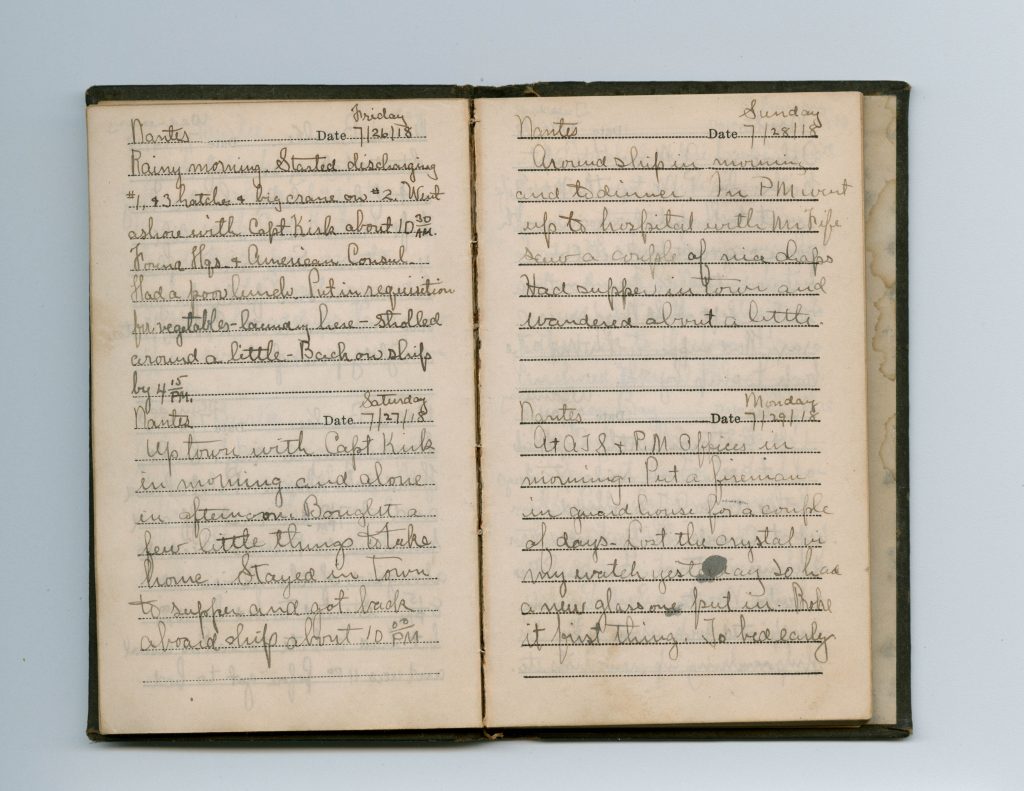by Susan Martin, Senior Processing Archivist
I’ve written for the Beehive many times about my particular affection for manuscript diaries at the MHS, and this post will be no exception. Today I’d like to tell you about the diary of Lester Locke Downing of Cambridge, Massachusetts.

Downing served as a second lieutenant in the U.S. Army Transport Service during World War I. This pocket diary documents his service between 18 May and 20 December 1918 and his voyages back and forth between New York and France on the transport ship Osage. In these seven months, the Osage made three trans-Atlantic round trips as part of a large convoy. Downing’s brief but evocative entries really paint a picture of what his life at sea was like, both the monotony and the ever-present fear of submarine attack.
Downing didn’t have a lot of room to write in this small volume, but he managed to describe everything from how difficult it was to keep the convoy together (“At daybreak we were last ship in convoy. Speed of convoy is 10K. By 4:00PM in middle again. Only able to hold our own by not zig-zagging fully.”) to sightings of other ships, airplanes, airships, and animals (“Saw large school of porpoises & several large fish or turtles.”). His duties onboard included working on manifests, and in his down time, he usually read or played cards.
Whenever the ship was in New York for re-loading, Downing’s wife Elinor (née Haines) and mother Helen Adele (Locke) Downing came down from Massachusetts to visit with him for a few days, go to the movies, and eat out at restaurants. Then it was back to the ship and to France. The Osage landed at various locations to discharge cargo, including Saint-Nazare, Nantes, and Brest.
Because the diary entries are so short, the juxtapositions can be abrupt and jarring. For example, one day Downing wrote: “Passed to port a convoy eastbound. Tank steamer and 5 masted barge ahead also another steamer all westbound with us. A fine day. Pulled Captains tooth in afternoon. Mans body floated by in PM.” Other times, the lack of context makes an entry particularly eerie: “About 10:15AM passed a[n] empty life boat full of water.”
The convoy was in constant danger from enemy submarines, of course. Downing wrote about a few close calls, including this one in the middle of August: “Had submarine warning about 5:00PM. Right in our vicinity. Quite anxious. Steamer stern of us smoking.” He also mentioned a fellow sailor named Adolph Steinberg who suffered from trauma or mental illness (Downing used the words “demented” and “crazy”) and had to be left with the Medical Corps at Saint-Lazare.
What was the Osage’s cargo? The ship was transporting ordnance and chemical weapons, including picric acid, chlorine gas, explosive shells, and shrapnel. Picric acid was used extensively both as an explosive and as an antiseptic for the treatment of burns and trench foot. Chlorine gas, weaponized by both Allied and Central powers, attacked the respiratory tract and killed by asphyxiation.
Downing was on his third trip to France when he heard that Germany had signed the armistice. His entry that day was a bit anticlimactic: “Had had suspicions for some time.”
Lester Locke Downing was born on 16 March 1889, graduated with a degree in mechanical engineering from the Massachusetts Institute of Technology, and worked at Crowell & Thurlow Steamship Company in Boston. He was also an avid philatelist. He died on 25 July 1974 at the age of 85.

